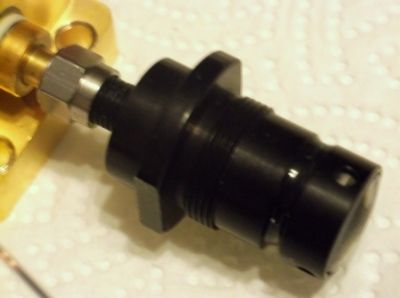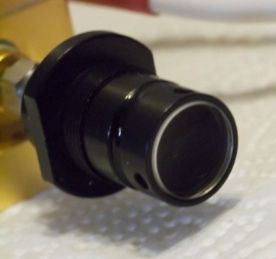Alaskan
0
- Joined
- Jan 29, 2014
- Messages
- 12,025
- Points
- 113
Finally got around to expanding & collimating the output of my Coherent FAP800 laser module to 2 inches beam diameter, sure makes the beam behave much better without so much spreading:
Below, photo's taken prior to expansion with a 12mm diameter collimator lens using approx 15-20% of output aperture. As you can see, the divergence is terribly wide compared to what we are used to with our laser pointers, far worse than even a multimode diode:


The above beams were through this 12mm aperture PCX lens which was directly coupled to the fiber output connector of the FAP800:


Beam shot after expansion from approximately 1 mm (fiber aperture 810 μm) to 50mm with resulting reduced divergence. To achieve the expansion and collimation I used a 12mm diameter -15mm focal length plano-concave lens inside the same lens holder shown above (removing the PCX lens from it first), followed by a large diameter plano-convex lens a few inches away, see the result below.

I was running low power just long enough to snap a couple of shots when I took this photo from a well guarded fixed point. Please excuse the grainy look, the camera is a very cheap digital camera with the IR filter removed and auto focus very confused. Anyone care to estimate the new reduced full angle mRad to check my thinking of what it might now be with a 2" diameter beam? ~5 mRad? It doesn't appear to be that wide of a divergence to me, I've seen wider with multimode laser diodes using a 6mm diameter collimation lens. Perhaps the spreading of the beam on the far end just isn't being picked up by the camera due to being less sensitive to IR giving the illusion the divergence is much less than it really is.
Here are two photo's of the output when at low power into a 12mm collimator, the beam spreads from about 1mm to 100mm at about 15 feet or 4.6 meters, using the online calculator at Laser Optics Calculators the divergence is about 21 mRad with this 12mm diameter lens, although a much smaller beam diameter when first leaving the lens. The photo on top was taken when the current was set so low the laser diodes were barely lasing, thus able to use the camera to take a picture shooting straight into the lens. Regardless, I still wore my goggles and kept the camera between myself and the laser output at all times. When I put my camera lens face to face with the laser output, the IR light from the fiber bundle was viewed as a very tiny spot, probably about 1mm diameter but at the distance away from the lens this top photo was taken, the beam has spread quite a bit to appear much larger.

The bottom photo of the two shows the beam pattern at about 15 feet away and 4 inches wide.
My camera couldn't focus on the IR very well as close to the spot as I was, but this gives an idea.
For this photo the output was at very low power, otherwise the intensity would completely wash out any detail.
What a FAP800 looks like:
http://www.coherent.com/downloads/FAP800series_DSFinal.pdf#page=2

More on this device here: http://laserpointerforums.com/f40/coherent-fap800-diode-array-divergence-question-95311.html
Below, photo's taken prior to expansion with a 12mm diameter collimator lens using approx 15-20% of output aperture. As you can see, the divergence is terribly wide compared to what we are used to with our laser pointers, far worse than even a multimode diode:


The above beams were through this 12mm aperture PCX lens which was directly coupled to the fiber output connector of the FAP800:


Beam shot after expansion from approximately 1 mm (fiber aperture 810 μm) to 50mm with resulting reduced divergence. To achieve the expansion and collimation I used a 12mm diameter -15mm focal length plano-concave lens inside the same lens holder shown above (removing the PCX lens from it first), followed by a large diameter plano-convex lens a few inches away, see the result below.

I was running low power just long enough to snap a couple of shots when I took this photo from a well guarded fixed point. Please excuse the grainy look, the camera is a very cheap digital camera with the IR filter removed and auto focus very confused. Anyone care to estimate the new reduced full angle mRad to check my thinking of what it might now be with a 2" diameter beam? ~5 mRad? It doesn't appear to be that wide of a divergence to me, I've seen wider with multimode laser diodes using a 6mm diameter collimation lens. Perhaps the spreading of the beam on the far end just isn't being picked up by the camera due to being less sensitive to IR giving the illusion the divergence is much less than it really is.
Here are two photo's of the output when at low power into a 12mm collimator, the beam spreads from about 1mm to 100mm at about 15 feet or 4.6 meters, using the online calculator at Laser Optics Calculators the divergence is about 21 mRad with this 12mm diameter lens, although a much smaller beam diameter when first leaving the lens. The photo on top was taken when the current was set so low the laser diodes were barely lasing, thus able to use the camera to take a picture shooting straight into the lens. Regardless, I still wore my goggles and kept the camera between myself and the laser output at all times. When I put my camera lens face to face with the laser output, the IR light from the fiber bundle was viewed as a very tiny spot, probably about 1mm diameter but at the distance away from the lens this top photo was taken, the beam has spread quite a bit to appear much larger.

The bottom photo of the two shows the beam pattern at about 15 feet away and 4 inches wide.
My camera couldn't focus on the IR very well as close to the spot as I was, but this gives an idea.
For this photo the output was at very low power, otherwise the intensity would completely wash out any detail.
What a FAP800 looks like:
http://www.coherent.com/downloads/FAP800series_DSFinal.pdf#page=2

More on this device here: http://laserpointerforums.com/f40/coherent-fap800-diode-array-divergence-question-95311.html
Last edited:






